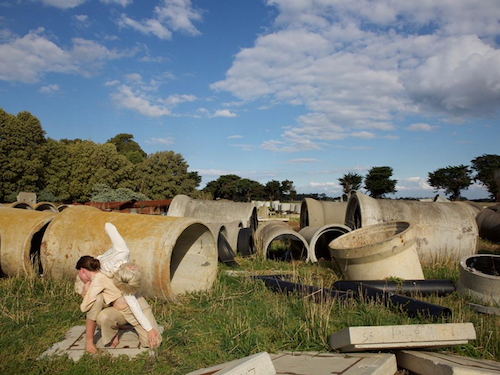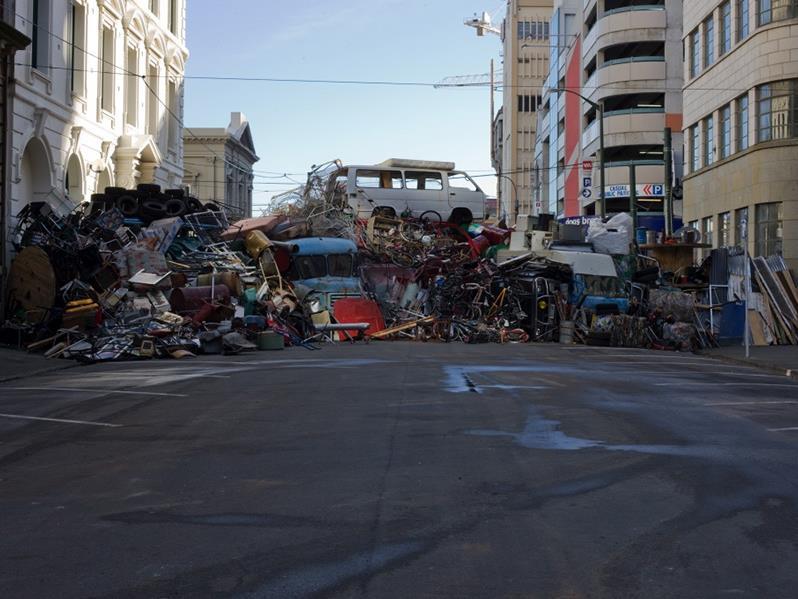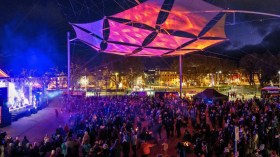The One Day Sculpture, a public art installation in New Zealand. Photo: Public Art Commission
Appropriately titled ‘Venetian Blind’, teams from Deakin University will travel each month to one of Europe’s most famous arts festivals. Upon arrival, each team will be given a provocation to respond to, and then a short timeframe in which to create their art. Their creations – which can be visual art or performative, and are anticipated to reflect real-time events within the city – will be documented within the traditional gallery space for the Venice Biennale, the Palazzo Bembo.
The project is being run by the University’s research initiative, the Public Art Commission, which was invited to produce the work by the Venice Biennale.
Commission Co-Director David Cross said the idea is to take artwork out of the usual gallery space in the Palazzo and encourage visitors to understand that art doesn’t just happen in singular, internal spaces.
‘Traditionally it is a gallery/museum space and its focus is very much on objects placed inside,’ he said of the Palazzo. ‘Our project is really inviting our artists to respond to a series of provocations that we have set them within the public sphere of Venice – so various locations, stories and histories.
‘Our artists can choose if they want to make a site-based project or performance project or an intervention into the landscape and they will document that work in the Palazzo space.’

The Public Art Commission team are dedicated to investigating new and unusual spaces for pubic artworks.
The teams will be comprised of students across the spectrum of disciplines taught at Deakin, including the School of Communication and Creative Arts disciplines such as writing and literature, film, drama, visual arts and photography. Teams will comprise three to four people and be a mix of academics and research students.
Cross said the aim of the ‘blind’ project, which will result in an accumulation of six months’ worth of artworks, is to encourage spontaneity and site-responsive skills, to help them build resilience and transferable skills inside and outside the gallery.
‘It might be slightly brutal in terms of the time they have to respond to the brief but we are interested in that unmediated experience of the city. So they are given a provocation to grapple with and then they go away and consider how they will respond to it,’ he said.
‘It also partly speaks to the new skills that artists need to have. Increasingly, artists need to be able to respond quickly, to build and research content quickly and to work collaboratively to take the temperature of a place and find ways to respond to that.’
Curator Cameron Bishop said exploring the way Deakin’s teams will explore public art within the Biennale is reflective of the work he and Cross are doing with the Public Art Commission. It effectively works to commission public art in Australia and overseas, helps to create scholarships and research, and acts as a consultant on public artworks, which in turn allows students the opportunity to gain hands-on experience.
One such work is Treatment, based in the Melbourne Water’s Western Treatment Plant in Werribee. The team created an experience in a very unusual environment which, owing to the large size of the area, required a bus to transport visitors around.
‘In doing that we actually managed to bring together an extremely diverse audience including ex-residents who lived in the old township, football players from the old footy teams as well as the intelligentsia from Melbourne,’ Bishop said.
‘That led to an extremely rich dialogue between those two cross-sections of the audience. And for us that is one of the more enriching aspects to what we do – the reactions of these people and the conversations that take place about the place, its histories and its importance in the daily life of Melbourne.
‘There is a real momentum around the work we are doing in the public sphere outside of the gallery space and that is something that really interests us.’

The Venice Biennale project will art out of the city’s traditional gallery spaces.
Bishop and Cross have also developed a 11-week public art unit for undergraduate students which offers the opportunity to create real-world artworks, and obtain a more in-depth understanding of how these projects are managed.
‘Those who do the public art unit are very excited by it,’ Bishop said. ‘It is a very project-focused unit which allows for students to get a picture of how a public art event might run from a logistics and OH&S perspective as much as the bureaucratic and political perspectives, too.
‘It helps us to engage students in authentic ways, which is important for us. We don’t just demonstrate things on a white wall; we actually make art in public spaces.’
If you’re also looking to chase a creative career, take a look at Deakin’s creative arts courses. Visit the website for more information.





